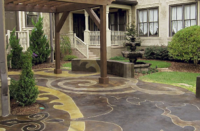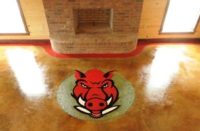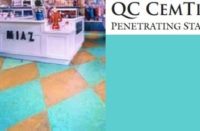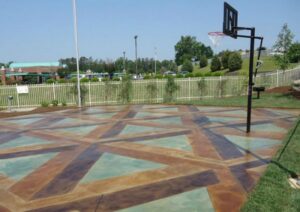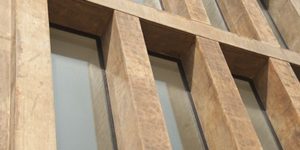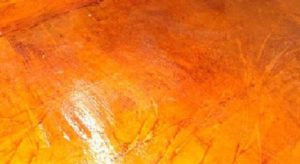 |
 |
Longtime artist and acid stain master Gaye Goodman, 66, wasn’t always a guru of colored concrete.
She spent the early part of her career creating batiks and abstract paintings. Forms found in nature often served as her inspiration. As she worked to get her pieces into gallery exhibits, she took a variety of jobs, including a stint as a flight attendant, and pursued other forms of art, such as belly dancing and the harp.
Goodman moved to Albuquerque, N.M., where her brother resided, in 1993. There, she worked part time in real estate and as a waitress while she continued to pursue her art. She soon discovered a new niche that would land her commercial jobs: faux painting, a skill that involves recreating the colors and patterns of materials such as marble and wood on walls, floors and furniture.
In 1995, she was asked to faux paint the floor of O’Hare’s Grille & Pub, a new restaurant in Rio Rancho, N.M., to make it look like marble. She visited the showroom of product distributor Concrete Systems Inc. in Albuquerque, where she planned to purchase an acid cleaner for the floor.
 |
 |
 |
An employee there suggested Goodman use acid stains on the floor instead of paint. Despite having no prior experience with concrete floors, she walked out of the showroom with L. M. Scofield Co. acid stain products and written instructions, and decided to go for it.
Working with her neighbor — a paper maker and her first Faux Real LLC employee — Goodman spent three months turning the surface into an elegant, acid-stained floor in hues of cream, tan and brown. They experimented on the floor behind the bar area, which would be covered with mats, before moving on to the restaurant’s main floor. Their learning process included trying six different kinds of tape before finding one that would adhere properly as they blocked off square- and rectangular-shaped sections to create borders and intersections.O’Hare’s Grille & Pub was her company’s first official job and what got her hooked on acid stain, she says.
“It was perfect for me,” Goodman said. “The stain flows to unexpected places on the slab. Artists depend on serendipity and chance happenings, and I thought it was so cool because I didn’t know exactly what would happen. I thought, wow, this looks like what I’ve been trying to do with my paintings.”
Goodman’s business began to grow, thanks partially to luck — as the only restaurant at the time with beer on tap in rapidly growing Rio Rancho, O’Hare’s Grille & Pub became very popular. She also took hints from her business-minded brother, a management consultant in Albuquerque, and sent out promotional flyers that showcased photos of her first stained floor to every architect and builder in town.
Over the years, Faux Real LLC has focused on indoor, residential floor staining projects in New Mexico and has landed the same kind of work in California, Arizona and New York. Goodman also works in an educational role in the concrete staining community as a creator of how-to videos and manuals and as a seminar leader, which she says has produced an additional steady flow of income for her company.
 |
 |
 |
Goodman has always hired artists and musicians onto her Faux Real crew — she says they “understand the importance of chance” in concrete staining, and as a lifelong artist herself, she sees eye-to-eye with people who have a passion for the arts. The company has always been small, with seven employees at most.Faux Real LLC has never offered decorative concrete applications outside the realm of staining, and Goodman says she’s never regretted that choice. “I wanted the artistic impact of random chance, which only staining can provide.”One product that made an impact on Goodman’s career is L. M. Scofield’s Lithochrome Chemstain Classic in Weathered Bronze, which she says could produce a variety of shades, including greens and browns. She first tried it in 1998 while staining the floor of a notable residence in Albuquerque and used it multiple times since. (She says batches of the stain she’s bought more recently do not offer the multicolor effect.)
Faux Real’s flagship floor-staining projects include the Santa Fe Arcade in Santa Fe, N.M., in 2004 and the Albuquerque Balloon Museum in Albuquerque in 2006. For the Santa Fe Arcade project, Goodman and her team sprayed Lithochrome Chemstain Classic in Copper Patina, Fern Green and Weathered Bronze in adjoining puddles at random, then dropped thin plastic sheets into the wet stain from wall to wall to add texture.
“The architect thought the plastic marks were too strong, so after cleaning, we restained the whole floor with the same three colors, again at random,” Goodman says of the Santa Fe Arcade project. “This slab was unusually reactive to the stain, so we got the most intense turquoise colors I have ever seen on a floor.”
 |
 |
 |
 |
Goodman ensures her clients are fully involved throughout the duration of a project. She gives them several chances to change their minds about color schemes. She wouldn’t call herself a salesperson, but says her strong enthusiasm for acid staining is often what gets her work sold.
“I have found that if I’m excited by some new combination I’ve recently worked out, the enthusiasm is quite contagious,” she says. “I don’t have to do any selling, really. I just do samples and show them with obvious excitement and the client goes there with me.”
Down the line, Goodman says she’d like to land more commercial jobs and stain more museum floors, but her bigger dream is to spread acid staining around the world.
“I think there is a huge untapped potential in developing countries in South America, in the Middle East and in India,” she says. “If someone were to build a stain-and-sealer factory in an exotic country and invite me over to train crews and demonstrate so a new cottage industry could be born, I would go in a heartbeat.”
In the meantime, she’ll continue to enjoy working with acid stains and their unpredictability, which is what she says keeps her and her crew excited about their work.
“I just adore acid stains and the random, natural way they combine,” she says. “If they were always predictable I would have quit a long time ago, because there is so much drudgery involved in the preparation stage. But doing the post-stain scrub on a floor we stained the previous night still feels like Christmas morning to me, and that is the whole secret of what keeps me and my crew going.”
www.gayegoodman.com
